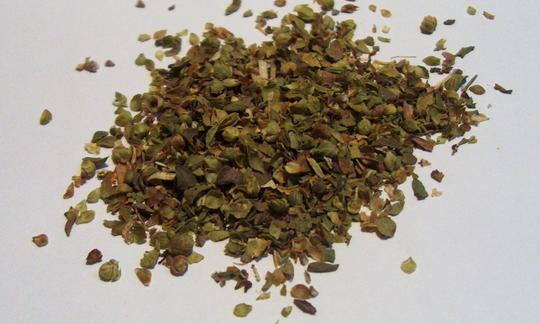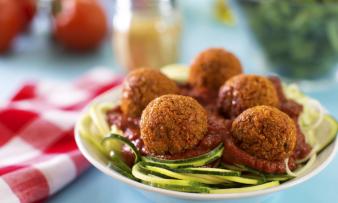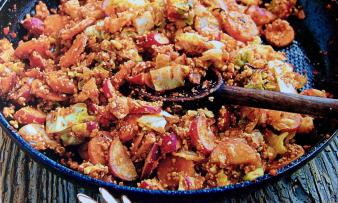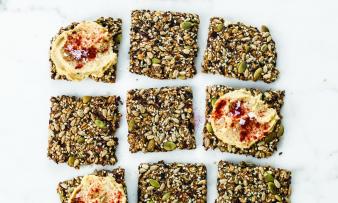Table of contents
Dried oregano ( Origanum vulgare ) is used as an organic spice and medicinal plant. Gently dried, also available in raw food quality ( raw ).
Use in the kitchen
Oregano plays a rather minor role as a spice in German cuisine. In the Mediterranean region, especially in Italian, Greek and Spanish cuisine, oregano is an important herb. Oregano has a tart, peppery-bitter taste.
What do you use oregano for? Oregano goes well in a tomato sauce or in a pepper soup . It also tastes delicious in vegetable casseroles, on pizza, in stews and in salad dressings. The herb goes well with most Mediterranean dishes. Together with dried thyme , rosemary and savory, oregano is present in most " Herbs de Provence" mixtures . It can also be combined well with sage , bay leaves , basil and marjoram .
There are several subspecies of oregano (subsp.). Compared to other subspecies, genuine Greek oregano has the best quality in terms of essential oils, which are crucial for the taste. 13 On a scale of 1 to 10 for intensity and taste, Greek oregano gets a value of 10, and marjoram ( Origanum majorana ) gets a value of 3. Greek oregano thus also surpasses Syrian oregano ( Origanum maru ).
Can you eat oregano raw? You can eat oregano raw. You can find out more about its use under the link Greek oregano, raw (organic?) . Gently dried oregano is also available in raw food quality.
Making your own dried oregano
Oregano should be harvested during flowering (mainly July-August), as this is when its aroma is strongest. Oregano should be cut on a warm, dry day in the late morning. Cut the shoots with a sharp knife or scissors about a hand's breadth above the ground, or 15 centimeters below the flower. Check the shoots and remove yellow or diseased leaves, as well as insects and dirt by gently shaking the shoots. Do not wash the oregano before drying. 3
How should you dry oregano? Air drying is particularly gentle in a warm (20 to 30 °C) but dark, well-ventilated and dust-free room. You can tie the oregano shoots into a small bundle and hang them upside down or lay them out loosely on baking paper. You can also dry oregano in the oven at 30-35 °C. To do this, lay the shoots loosely on a baking tray lined with baking paper and dry them slowly in the oven for 1 to 2 hours. Make sure to leave the oven door slightly open so that moisture can escape. Alternatively, you can also dry oregano in a dehydrator at a maximum of 40 °C. 3
As soon as the bundles rustle, the stems break easily and you can rub the leaves between your fingers, the oregano is perfectly dried. Carefully strip the dried leaves from the shoots (rebel) and fill them into airtight containers or screw-top jars. These must be stored in a dry place protected from light. 3
Vegan recipe for tomato gazpacho with oregano and thyme
Ingredients (for 2 people): 6 beef tomatoes , 1-2 cloves of garlic , salt ,black pepper , paprika powder (sweet) , chili flakes , 1 teaspoon dried thyme , 1 teaspoon dried oregano, 10 g pine nuts (unroasted) .
Preparation: Wash, peel and dice the tomatoes. Peel the garlic cloves. Puree the tomatoes and garlic in a blender. Season with salt, pepper, paprika powder and chili flakes. Add the thyme and oregano. Cover and chill the gazpacho mixture in the fridge for at least 2 hours. Wash the thyme and oregano and shake out the water well. Carefully remove the leaves from the stem and stir into the gazpacho mixture. Pour the vegan gazpacho into bowls or deep plates and garnish with the unroasted pine nuts.
Tea preparation
For one cup of oregano tea, take 1 teaspoon of dried oregano and pour 250 ml of hot water over it. Cover and let steep for 5 minutes, then filter with a sieve and sweeten if necessary.
Vegan recipes with dried oregano can be found under the note: " Recipes that have the most of this ingredient ".
| Not only vegans or vegetarians should read this: Vegans often eat unhealthily. Avoidable nutritional mistakes . |
Purchasing - Storage
Large retailers such as Coop , Migros , Denner , Volg , Spar , Aldi , Lidl , Rewe , Edeka , Hofer and Billa sell dried oregano, some of which are organic. Health food stores and organic supermarkets such as Denn's Biomarkt and Alnatura also sell dried organic oregano. It is rare to find oregano in raw quality (gentle drying). However, you can easily make it yourself.
What does dried oregano look like? Dried oregano is usually brown-green in color. Freeze-dried oregano sometimes has a more intense green color. "Dried" means that the dried leaves are stripped from the stems of the plant and then roughly chopped.
The availability of dried oregano varies depending on the size of the store, catchment area, etc. If you are interested, click on our recorded food prices for the DA-CH countries (above under the ingredient image). There you will find current prices and, by clicking, their development at various suppliers.
In its pollutant check on September 23, 2020 , Stiftung Warentest found very large differences between suppliers (34 brands), including some organic products. It was about ordinary oregano (vulgare, 21 times, 9 of which were organic) and marjoram, each dried. The main things they were looking for were pyrrolizidine alkaloids (PA) and pesticides. Organic quality from Azaran, Herbaria and Lebensbaum passed the test without any problems. Three non-organic products had to be advised against due to health concerns! 14
the wild
Oregano can be found in in the DA-CH countries, sometimes on limestone and gravel soils in warm places such as south-facing slopes, embankments, southern forest edges and poor meadows. 2
Storage Tips
Dried oregano should be stored in glass or metal containers, away from light and moisture. Storing oregano in plastic containers is not a good idea, as plastic can absorb the essential oil and affect the taste.
Ingredients - Nutritional values - Calories
Here we realistically show you the ingredients of spices and herbs per 1 g (instead of per 100 g as usual).
1 g of dried oregano (raw) has a calorie content of 2.65 kcal. It contains 0.69 g carbohydrates, 0.09 g protein and 0.04 g fat. 1
Does oregano contain vitamin K? 1 g of dried oregano contains 6.2 µg of vitamin K , which corresponds to 8.2% of the daily requirement. Herbs rich in vitamin K are dried wild garlic (26.3 µg/1g), dried basil (17.1 µg/1g) and dried parsley (13.6 µg/1g). 1
The same amount of oregano provides 0.37 mg of iron and 0.05 mg of manganese . In comparison , dried thyme contains significantly more iron (1.24 mg/1g) and slightly more manganese (0.08 mg/1g). 1
Oregano is rich in essential oils that contain carvacrol, thymol, terpinene, linalyl acetate and p-cymene. 5
The complete ingredients of dried oregano, the coverage of the daily requirement and comparison values with other ingredients can be found in our nutrient tables. In the article Nutrients explained you will get a detailed insight into the topic.
Health effects
Oregano is rich in essential oils that can have a positive effect on health. These include large amounts of carvacrol and thymol, as well as terpinene (class of terpenes), linalyl acetate and p-cymene. The composition and content of the individual substances vary depending on the time of harvest, the geographical location, the environmental conditions and the parts of the plant used (stems, leaves). 5
Is dried oregano healthy? The essential oils that are largely responsible for the health benefits of oregano can be found in both dried and fresh oregano. Oregano oil has the highest concentration of these.
In vitro studies show that oregano has antioxidant, antibacterial, antimicrobial and antifungal effects. 5 Essential oils from oregano could be promising for the medical and cosmetics industries. Due to its antimicrobial and antibacterial effects, oregano is sometimes advertised as a "natural antibiotic". Its effect in the treatment of severe acne is also being investigated. Initial results in a mouse model are promising. However, a commercially available preparation is not yet available (as of 2018). 10 Its possible applications in the food industry are also being researched, as the demand for natural preservatives and antioxidants is increasing. 11
Dangers - Intolerances - Side effects
Allergic reactions to oregano are rare, but can occur. There is a known case of a 45-year-old man who had allergic reactions after eating food containing thyme or oregano. In addition to itching and swelling of the lips and tongue, he also had difficulty swallowing, breathing difficulties, eyelid edema, hypotension (low blood pressure), vomiting and nausea. An allergic skin test showed that the man also reacted to other spices from the Lamiaceae family. The control group, on the other hand, did not react to any of the spices. 12
During pregnancy, you should avoid excessive consumption of oregano, even as a tea or oil. The herb is considered to induce labor. As a seasoning in the kitchen, it is generally safe even during pregnancy and breastfeeding. 2.9
Use as a recognized medicinal plant
Oregano ( Origanum vulgare ) is not a recognized medicinal plant. HMPC ( Committee on Herbal Medicinal Products ) and ESCOP ( European Federation of National Societies for Phytotherapy ) have not yet examined oregano. Commission E issued a negative monograph because of insufficient evidence of its effects. 4
Folk medicine - natural healing
Oregano tea is used in a similar way to dried thyme for respiratory problems such as coughs (whooping cough) and bronchitis. It is also used as a bath additive for colds. It is also said to help with digestive disorders, diseases of the stomach and intestinal tract, diarrhea and abdominal complaints. Oregano tea is rarely used as a gargle for throat and mouth infections. 2,4
Ecological footprint - animal welfare
The CO 2 footprint of a food depends on various factors. The type of agricultural production (conventional vs. organic), average or seasonal or regional production, domestic production or import by truck, ship or plane, different types of packaging and whether the goods are fresh or frozen all play a decisive role. 15 In a study of the ecological footprints of different herbs with different cultivation methods, an ecological CO 2 footprint of 0.069 kg CO 2 eq/kg was found for oregano from organic farming, and 0.089 kg CO 2 eq/kg for oregano from conventional farming. 16 The increased value for conventional oregano results from the use of pesticides and synthetic fertilizers, the use of which is prohibited in organic farming. Ideally, you should buy oregano from organic farming or grow it yourself, which also saves unnecessary transport and packaging.
The amount of water needed to produce 1 kg of oregano is about 325 litres. 16
Due to its high sugar content, the oregano flower is very attractive to pollinators such as bees, but also butterflies or hoverflies 17 and can thus contribute to an insect-friendly garden or balcony.
Worldwide occurrence - cultivation
Oregano originally comes from the Mediterranean region, but also grows in Central Europe on limestone and gravel soils in sunny locations. 2 It has also been introduced to the east and west coasts of North America. 5 The popular spice is often grown in the garden or in a pot on the balcony. The main growing area for commercially produced oregano is Turkey. 5
Growing in the garden
The plant prefers a sheltered, warm, sunny location. The soil should be relatively low in nutrients and permeable to water. Oregano can be grown well in a pot on the balcony. Oregano does not like waterlogging at all, which is why permeable soil with good drainage is important. 6
From the end of February you can sow oregano for pre-cultivation so that you can plant it out from May. Alternatively, you can sow it directly outdoors from the end of May. The herb is a light germinator, which means that the seeds must not be covered with soil. 6
Not all subspecies are winter hardy and so you have to sow them again the following year. Real Greek oregano is relatively winter hardy (down to -15 °C). From mid-August onwards you should stop fertilising and cutting the herb back. Both of these things encourage the formation of new shoots, which will not fully mature by winter and can therefore freeze. The ground around the plant should be covered with fir or spruce branches to protect the roots from frost. 6
You can harvest the fresh leaves and shoots of oregano at any time. However, you should not harvest the plant completely after flowering, as otherwise it will not be able to grow enough again by winter. To dry oregano, cut it off about 15 centimeters below the flower during the flowering period. 6
Industrial production
In commercial production, sieves or blowers clean the oregano of sand, earth or stones. Then special mills mechanically shred the oregano leaves. In industry, raw oregano leaves are mostly dried using hot air in special ovens or on belts. In freeze-drying, the herbs are shock-cooled to -18 °C using liquid nitrogen. In a vacuum, the ice that is created turns directly into a gaseous state (water vapor) and can be easily sucked off. This technique is more expensive, but ensures that the herbs retain their structure, natural color and flavor even over longer storage periods. 7
Herbs are sometimes contaminated with germs that can be harmful to our health or reduce their shelf life. Therefore, these are removed using special steam and heat disinfection processes. Treatment with ionizing radiation is permitted within the EU . This method is not used in every EU country and some countries only import non-irradiated goods. 7
Further information
Oregano ( Origanum vulgare ) belongs to the genus Oregano or Marjoram ( Origanum ) in the mint family (Lamiaceae). Well-known species of Oregano are Greek oregano ( Origanum vulgare subsp. hirtum ), Turkish oregano ( Origanum onites ), Syrian oregano ( Origanum maru ) and Marjoram ( Origanum majorana ). Mexican oregano ( Lippia graveolens ; Spanish: hierba dulce ), however, belongs to the verbena family ( Verbenaceae ).
Food fraud sometimes occurs by stretching the dried oregano with olive tree leaves. The problem has been recognized and countermeasures have been initiated. In contrast to other foods, the trade in herbs and spices is still not very transparent and quality labels are only just being introduced (2023). 8
Alternative names
Common names for oregano are Dorst, Dost, True Dost, Common Dost, Common Marjoram or Wild Marjoram. Greek oregano is a subspecies that is also called false marjoram, Greek oregano, Italian oregano and pizza oregano.
The English name is oregano.











Comments